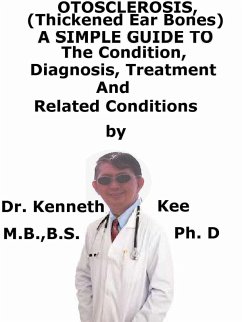Otosclerosis is an abnormal bone growth in the middle ear that produces hearing loss.
There is abnormal bone metabolism affecting the stapes, oval window and the otic capsule.
It leads to the progressive fusion of the stapes footplate and ultimately sclerosis of the cochlea in advanced cases.
Otosclerosis (OTSC) is the single most frequent cause of hearing impairment.
It is a genetically controlled metabolic dysplasia, involving the bony tissue of the otic capsule (the skeletal elements enclosing the inner ear mechanism) and the auditory ossicles.
The otic capsular bone is unusual in that, after early development, it does not undergo extensive re-modeling.
In OTSC there is a pathological higher bony change leading to sclerosis and malfunction of sound conduction mechanism from ankylosis of the stapes footplate in the fenestra ovalis (oval window)of the cochlea.
This produces a slowly progressive conductive hearing impairment.
In some cases, the disease process may also extend from bony tissue to the cochlea itself, causing a mixed conductive and sensorineural hearing loss.
Incidence
Otosclerosis is the most frequent source of middle ear hearing loss in young adults.
It normally starts in early to mid-adulthood.
It is more frequent in women than in men.
Certain races such as Caucasians and Indians are more prone to have otosclerosis.
Causes
The exact cause of otosclerosis is not known.
It may be inherited through families.
OTSC is inherited in an autosomal dominant fashion with inconsistent penetrance
The interplay of genes with environmental factors is believed to be vital in the phenotypic activation of genetic susceptibility
Environmental factors implicated in the cause of otosclerosis are:
1. Estrogens,
2. Fluoride and
3. Viral infections such as measles.
People who have otosclerosis have an atypical sponge-like bone growing in the middle ear.
This growth stops the ear bones from vibrating in reaction to sound waves.
These vibrations are needed in order for the patient to hear.
The disorder may involve one or both ears.
The abnormal deposition and the hardening of the bone in the region results in the fixation of the stapes footplate, with concomitant conductive hearing loss.
The active bone remodeling may involve and injure the cochlea through the release of proteolytic enzymes or direct damage to the cochlea and spinal ligament.
Symptoms
1. Hearing loss 70%
2. Ringing in the ears (tinnitus)
3. Vertigo or dizziness
These symptoms are also found in Meniere's Disease.
The start of hearing loss normally begins between the age of 15 and 45 years and then slowly progresses.
Signs:
Schwartz sign which is a faint reddish hue seen over the cochlear promontory through the ear drum
Rinne's tuning fork test would be negative
Weber's test will move to the affected side
Diagnosis
A hearing test (audiometry) determine the seriousness of hearing loss.
Temporal-bone CT scanning may be done to determine other causes of hearing loss.
Treatment
No treatment is needed until the patient has serious hearing problems.
Hearing loss can be improved with correct use of bilateral hearing aids.
Surgery can cure or improve conductive hearing loss.
Either all or part of one of the small middle ear bones behind the eardrum is excised (stapedectomy) and replaced with prosthesis.
This surgery has now been mostly replaced by stapedotomy
The stapes are removed except for the footplate
A small hole using a laser is made in the footplate
The stapes piston is then inserted into the vestibule
Surgical therapy has improved significantly with new stapes pistons
The success rate is close to 90%
TABLE OF CONTENT
Introduction
Chapter 1 Otosclerosis...
Dieser Download kann aus rechtlichen Gründen nur mit Rechnungsadresse in A, B, CY, CZ, D, DK, EW, E, FIN, F, GR, H, IRL, I, LT, L, LR, M, NL, PL, P, R, S, SLO, SK ausgeliefert werden.


